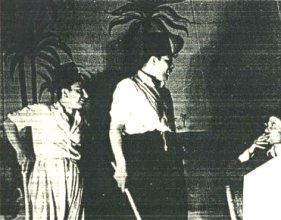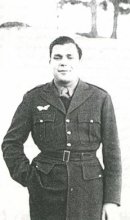Articles | Files | Interactive | Lists | Specials
The Rahbani Brothers Biography
|
Part 2: Father Paul elAshaqar, theater attempts and the policemen careers: The Rahbani family returned to settle in Antelias around 1938. Hanna Rahbani went back to his work in the cafe, and Assy and Mansour got to meet Father Paul Elashqer. He had moved to Antelias and was trying to form a choir. Assy and Mansour both asked to get into his choir, but only Mansour got in. Assy was rejected because of his voice. But that didn't break his will, and he used to go and attend the classes from a distance. One day Father Elashqer asked his students if anyone can explain the Tetracorde theory, but only Assy stepped to explain it. That was when Father Elashqer finally accpeted him in the choir. And so Assy and Mansour joined the religious choir in church, and they also started learning the basics of music. But they didn't have any musical instruments, and sometimes, in his absence, they would pick their father's Bizq and play with it. They used to stay at church for long times playing on the Piano and Organ that someone went to their father and told him his sons turned the church to a nightclub. Their father, conservative and religious, made them leave the church and go back helping in the cafe. That was until Father Elashqer told him to let them return to the church since what they did stemmed from religion and didn't degrade it. In one summer day when they were visiting the Dhour Elshewayer cafe, Assy found ten Liras in the cafe. He told his father about it, and Hanna decided to hang the money on the cafe's door so the one who lost it will see and take it. But days went and no one came to take it, and so Assy replaced it with a fake note and used the ten Liras to get a violin. Assy got enrolled in the national conservatoire and studied under Edward Ghaheshan. He and Mansour continuted their education with Father Elashqer who provided them with important resources like Alrisala AlShahabia, which is one of the most important books on Arabic music, as well as Elfarabi, Elkendi and Kamel Elkhalaey books. They also got to know about Byzantine and Syriac music and compositions. One of the Rahbani brothers compsitions which they were proud of is the one they wrote and dedicated to Father Elashqer on his birthday. During the late thirties and up to the mid fifties, there was a theatrical renassiance in Lebanon. There were many working troupes based in Beirut, aside from the music and song concerts that were regularly performed. The Rahbani brothers too expressed their interest in working in the theater. They started adapting some of the written plays of a friend of the family, Youssef Louis Abu Jawda. But they encountered financial and technical difficulties producing the plays. Mansour recalls two incidents from those times. One was when they wanted a girl to play one of the roles, but since actresses didn't get much respect amongst the common folk, they found difficulties getting one to work with them. They finally picked one of their kins, and tried to convince her father who didn't agree until they told him that all she'll do is read a speech to the priest attending the play. The role, however, was of a wife whose husband slaughters a cat to terrorize her on the wedding's night. And on the night of the performance, one actor had a real cat with him which jumped off the stage into the laps of the audience including that of the priest. Not long afterwards, the father went on stage and grapped his daughter forcing them to end the play. In another play, they wanted to bring a real donkey on the stage. When they wanted to get it on the stage, it refused to move, and so some young people from the audience tried to help the actors push the donkey. As soon as they reached the edge of the stage, it broke and the donkey fell.
In 1942, Assy got a job as a policeman in Antelias. Because of lack of personnal, he would sometimes issue orders and carry them out himself. Since he was making a living, he used to spend the money in attending concerts and buying musical instruments. One year later, Mansour joined his brother in the police force, except he was assigned to the national security in Beirut. The Antelias district officer, then Wadi Eshemali, was too a music enthusisat, and he and Assy and Mansour held many concerts. While in their police careers, Assy and Mansour continued with their theater works. They, and with other young people, formed a cultural club which they called 'Nadi Antelias'. They adapted stories and written plays and performed them in the club. Of these were Emil Habshi Elashqer's Hasnaa Alhijaz, Farid Abu Fadel's Alnoueman Athaleth Malk Alhira which they rewrote and added music to in order to make operatic. They also wrote a musical play called Elia. Most of these plays were performed for one or two nights only, and there were many unexpected things happening like when fire got out of control in one play and spread to the set which forced Mansour, who was dead on stage, to jump up to help control the fire to which the audience started poking fun shouting "The dead has risen". In the summer of 1943, a flood destroyed the cafe, and the one at Antelias wasn't profitable anymore. Then brothers of three sisters and one brother, Assy and Mansour were required to help their family financially. On Christmas eve of 1944, Assy and Mansour were being awarded by the town for the cultrual achievments they helped accomplish. But in that night also, their father, Hanna Rahbani, died.
|
Part: 1 | 2 | 3 | 4 | 5 | 6

